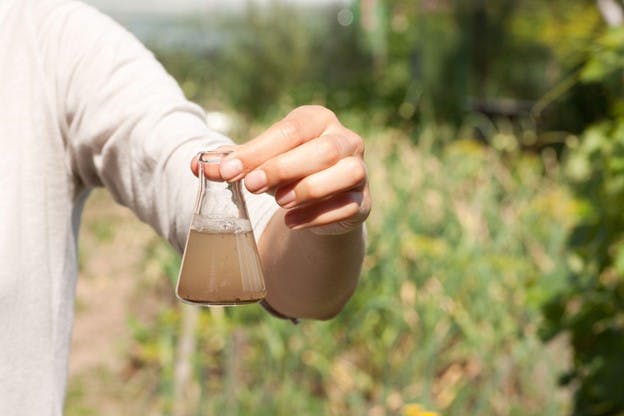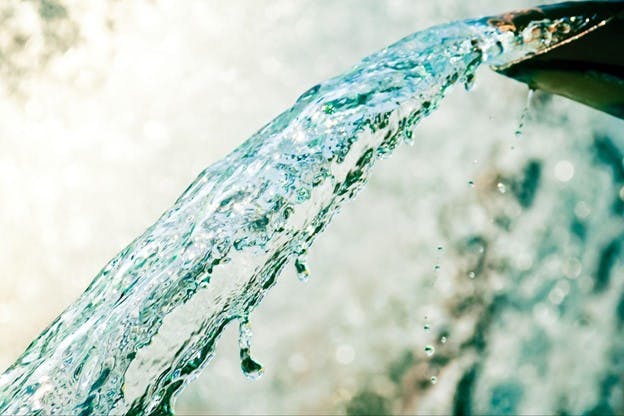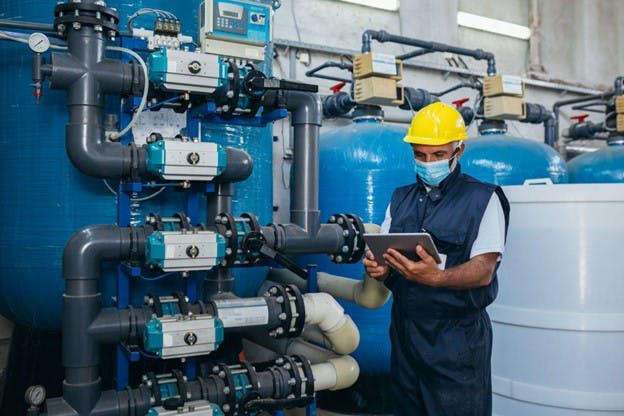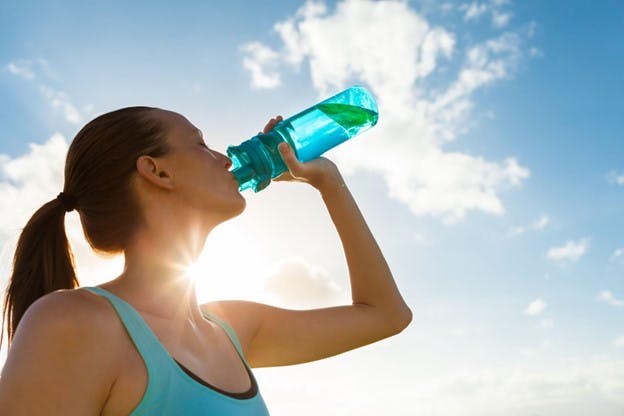🌟 New Arrival! Upgrade Your Water with Our Advanced Pitcher Filter. Shop Now
April 2023
Chloramines and Chlorine in Water: Are They Safe to Drink?
There’s nothing quite like spending summers by the swimming pool. The memories of pruney fingers, cannonballs, and the general chaotic fun of it all can be brought to the forefront of the mind by the familiar smell of chlorine.
Of course, you probably don’t have to go to a pool to find that smell. For most people in the U.S and Canada, just turning on your tap will carry you right back to that simpler time — but in a much less pleasant way.
That’s because modern water treatment plants often add chlorine and chloramines to your drinking water for the same reason they add it to the community pool — to disinfect it.
Since most of us don’t want to drink pool water, it begs the question: Should you drink chlorinated water from your tap?
We’re going to take a deep dive into municipal water to figure out just why they put chlorine in water, whether it’s safe to drink, and what chloramines are all about.
Why Does Water Need to Be Disinfected With Chlorine?
The water that comes into your home is either groundwater or it got sucked out of a lake, river, or some other surface water source. This water may come into contact with and may be contaminated by:
- Microorganisms
- Storm/agricultural runoff
- Synthetic chemicals like PFAS
- Microplastics
- Animal waste
- Sewage
- Heavy metals
- Minerals and salts
- Pharmaceuticals
- Decaying organic matter
As you can imagine, pulling water out of a hole in the ground and drinking it is most likely not safe without treatment. That’s where chlorine and chloramines come in.
How Does Chlorine Get Into Water?
Chlorine is not naturally occurring in water — it has to be added. Public water systems add chlorine to the water supply to limit waterborne disease outbreaks.
Microorganisms and pathogens living in water have long been a public health concern. Waterborne diseases like cholera, dysentery, and typhoid fever were once commonplace but chlorine disinfection of drinking water systems has helped us to leave these and other concerns in the past.
Chlorine has greatly improved our health and quality of life. Even if it does do its job optimally though, the question remains of whether you should drink chlorine in water.
Is Chlorine in Water Safe?
Like with most water treatments, the dose makes all the difference between safe drinking water and a hazard. The levels of chlorine that water treatment facilities use is dependent on many factors but there’s a limit (4 mg/L) to how much chlorine residue is allowed to reach your faucet. According to the U.S. Center for Disease Control (CDC) and the U.S. Environmental Protection Agency (EPA), chlorine in water is safe to drink in these concentrations.
Chlorine does cosmetically affect water quality though. Chlorine is known to dry out skin and hair. The bleach-like taste and odor can also be very off-putting if it is coming from your tap.
The real safety concern with chlorine isn’t dry skin but the disinfection byproducts (DBPs) that form in treated water. When chlorine interacts with organic compounds during the water treatment process, DBPs like trihalomethanes (THMS) and haloacetic acids like HAA5 and HAA9 form.
The potential health risks introduced from DPBs are a disadvantage of water chlorination vs. other disinfection methods like ultraviolet light or water chloramination.
What Are Chloramines in Water?
Chloramines are what you get when you mix chlorine and ammonia. If you’ve heard the advice never to mix bleach and ammonia, it's because the chloramine gas it creates can be life-threatening to inhale.
Chloramine comes in three varieties. Monochloramine, dichloramine, and trichloramine. Monochloramines are what’s used in water treatment systems.
Although these chemicals can be incredibly dangerous when mishandled, chloramines in water do some things better than chlorine while being perfectly safe when mixed and applied correctly by specialists.
One advantage is that chloramines stay active much longer than chlorine in water. This is helpful when water needs to travel a long distance from the municipality to your home.
This makes chloramines a great secondary disinfectant in pipes.
Are Chloramines in Water Safe?
More than one in five Americans now have water that has been treated with chloramines as either a secondary or primary disinfectant. According to the EPA and CDC, the use of chloramines as a drinking water treatment is safe in the right dosages.
While the chloramines in water are safe in small doses, they can still create carcinogenic DBPs when interacting with organic compounds. Because chloramines are more stable and don’t cause oxidation as fast as chlorine, the amount of DPBs created is far less.
The bleach taste and smell is also less potent than when using chlorine.
What Is the Disadvantage of Chloramine?
One of the major disadvantages of the use of chloramines in water is that they cause more corrosion, as well as copper and lead leaching from your pipes. This can mean damage to your plumbing and dangerous heavy metals in your water.
Chloramines are also less potent so they require more contact time with contaminants.
Because chloramines last longer, but also need more contact time, chloramine disinfection is a popular choice for larger water systems where the water has further to travel before reaching homes and businesses. It's also often used as a secondary disinfectant.
What Is a Primary Disinfectant vs. a Secondary Disinfectant?
Primary disinfectants do most of the heavy lifting in killing or inactivating viruses and bacteria at the source. Secondary disinfectants play a role when the water is traveling through pipes. They make sure more pathogens aren’t picked up along the way. In most cases, chlorine is used as the primary disinfectant while chloramines are used as secondary disinfectants.
This isn’t always the case though. Chloramines can work better as primary disinfectants when dealing with some pathogens, such as the bacteria that causes Legionnaires disease. For this reason, and because chloramines create fewer DPBs, some cities use chloramines as their primary disinfectant.
How Do I Know What My Water Utility Uses?
Many water utilities switch back and forth between chlorine and chloramines depending on the season and changes made to their systems. Temperature can cause chlorine to evaporate too quickly while chloramines can cause a film to develop on the inside of pipes.
You may notice a change to the bleach taste in your water if your utility switches from one to the other.
If you want to know which one your water supplier uses primarily, look at their water quality report. Water utilities are required to issue this report every year by the EPA.
You can also test your water for disinfectants and other contaminants. You’d either work with a local lab or pick up a home test.
How Can I Remove Chlorine and Chloramines From My Drinking Water?
Water treatment with chlorine and chloramines is important to make sure the water that reaches your tap is low in illness-causing pathogens. However, once it reaches you, there is no benefit to consuming the chlorine or chloramine in your water.
If you don’t enjoy the taste or would feel better not drinking chemicals when you don’t have to, HomeWater filters can remove chlorine, chloramines, DPBs, and a whole host of other water impurities.
Can I Use Chlorinated Water or Chloraminated Water With My Home Dialysis Machine?
If you’re using a home dialysis machine, removing chlorine and chloramine becomes more than a taste and smell preference. You should consult the manufacturer of your machine for this information but in many cases, using chlorinated water/chloraminated water is not advised.
Can I Use Chlorinated Water or Chloraminated Water in an Aquarium?
Chlorine and chloramine are considered toxic to fish and other aquatic animals. You’ll want to filter them out before using the water. If you don’t have a capable water filter, it could be as simple as just giving your water a few days in the open for the chlorine to evaporate out. We recommend consulting your local pet shop for information on how you can keep your fish tank friends safe.
Chlorine and Chloramines Keep You Safe But That Doesn’t Mean You Have to Drink Them
Adding chlorine and chloramines to water is a longstanding practice that has undoubtedly saved millions of lives. While these water disinfectants are well-monitored and generally considered safe, their tendency to dry out your skin and hair, change the taste of your water, and create potentially dangerous disinfection byproducts is enough reason for many people to remove these additives once they reach your home.
HomeWater filters can help you remove chlorine and chloramines from your water as well as any disinfection byproducts created on the way. If you want the highest quality water flowing from every faucet and appliance in your home, try our affordable, American-made 4-Stage Whole Home filtration system.
Or, if you want an easy-to-install alternative, our 4-Stage Reverse Osmosis Under Counter Water Filter will give you great tasting water straight from your tap. Add a shower head filter to keep your skin and hair happy and healthy, too.
HomeWater will take your safe water and make it delicious.



